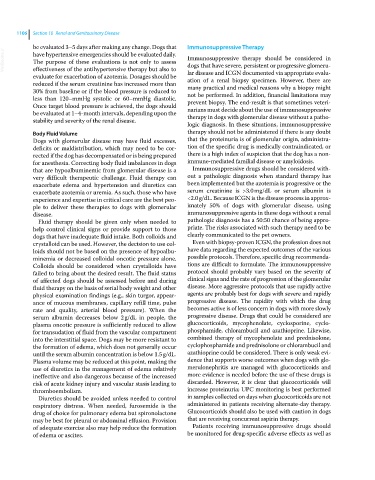Page 1168 - Clinical Small Animal Internal Medicine
P. 1168
1106 Section 10 Renal and Genitourinary Disease
be evaluated 3–5 days after making any change. Dogs that Immunosuppressive Therapy
VetBooks.ir have hypertensive emergencies should be evaluated daily. Immunosuppressive therapy should be considered in
The purpose of these evaluations is not only to assess
dogs that have severe, persistent or progressive glomeru-
effectiveness of the antihypertensive therapy but also to
evaluate for exacerbation of azotemia. Dosages should be lar disease and ICGN documented via appropriate evalu-
ation of a renal biopsy specimen. However, there are
reduced if the serum creatinine has increased more than many practical and medical reasons why a biopsy might
30% from baseline or if the blood pressure is reduced to not be performed. In addition, financial limitations may
less than 120–mmHg systolic or 60–mmHg diastolic. prevent biopsy. The end‐result is that sometimes veteri-
Once target blood pressure is achieved, the dogs should narians must decide about the use of immunosuppressive
be evaluated at 1–4‐month intervals, depending upon the therapy in dogs with glomerular disease without a patho-
stability and severity of the renal disease.
logic diagnosis. In these situations, immunosuppressive
Body Fluid Volume therapy should not be administered if there is any doubt
Dogs with glomerular disease may have fluid excesses, that the proteinuria is of glomerular origin, administra-
deficits or maldistribution, which may need to be cor- tion of the specific drug is medically contraindicated, or
rected if the dog has decompensated or is being prepared there is a high index of suspicion that the dog has a non-
for anesthesia. Correcting body fluid imbalances in dogs immune‐mediated familial disease or amyloidosis.
that are hypoalbuminemic from glomerular disease is a Immunosuppressive drugs should be considered with-
very difficult therapeutic challenge. Fluid therapy can out a pathologic diagnosis when standard therapy has
exacerbate edema and hypertension and diuretics can been implemented but the azotemia is progressive or the
exacerbate azotemia or uremia. As such, those who have serum creatinine is >3.0 mg/dL or serum albumin is
experience and expertise in critical care are the best peo- <2.0 g/dL. Because ICGN is the disease process in approx-
ple to deliver these therapies to dogs with glomerular imately 50% of dogs with glomerular disease, using
disease. immunosuppressive agents in these dogs without a renal
Fluid therapy should be given only when needed to pathologic diagnosis has a 50:50 chance of being appro-
help control clinical signs or provide support to those priate. The risks associated with such therapy need to be
dogs that have inadequate fluid intake. Both colloids and clearly communicated to the pet owners.
crystalloid can be used. However, the decision to use col- Even with biopsy‐proven ICGN, the profession does not
loids should not be based on the presence of hypoalbu- have data regarding the expected outcomes of the various
minemia or decreased colloidal oncotic pressure alone. possible protocols. Therefore, specific drug recommenda-
Colloids should be considered when crystalloids have tions are difficult to formulate. The immunosuppressive
failed to bring about the desired result. The fluid status protocol should probably vary based on the severity of
of affected dogs should be assessed before and during clinical signs and the rate of progression of the glomerular
fluid therapy on the basis of serial body weight and other disease. More aggressive protocols that use rapidly active
physical examination findings (e.g., skin turgor, appear- agents are probably best for dogs with severe and rapidly
ance of mucous membranes, capillary refill time, pulse progressive disease. The rapidity with which the drug
rate and quality, arterial blood pressure). When the becomes active is of less concern in dogs with more slowly
serum albumin decreases below 2 g/dL in people, the progressive disease. Drugs that could be considered are
plasma oncotic pressure is sufficiently reduced to allow glucocorticoids, mycophenolate, cyclosporine, cyclo-
for transudation of fluid from the vascular compartment phosphamide, chlorambucil and azathioprine. Likewise,
into the interstitial space. Dogs may be more resistant to combined therapy of mycophenolate and prednisolone,
the formation of edema, which does not generally occur cyclophosphamide and prednisolone or chlorambucil and
until the serum albumin concentration is below 1.5 g/dL. azathioprine could be considered. There is only weak evi-
Plasma volume may be reduced at this point, making the dence that supports worse outcomes when dogs with glo-
use of diuretics in the management of edema relatively merulonephritis are managed with glucocorticoids and
ineffective and also dangerous because of the increased more evidence is needed before the use of these drugs is
risk of acute kidney injury and vascular stasis leading to discarded. However, it is clear that glucocorticoids will
thromboembolism. increase proteinuria; UPC monitoring is best performed
Diuretics should be avoided unless needed to control in samples collected on days when glucocorticoids are not
respiratory distress. When needed, furosemide is the administered in patients receiving alternate‐day therapy.
drug of choice for pulmonary edema but spironolactone Glucocorticoids should also be used with caution in dogs
may be best for pleural or abdominal effusion. Provision that are receiving concurrent aspirin therapy.
of adequate exercise also may help reduce the formation Patients receiving immunosuppressive drugs should
of edema or ascites. be monitored for drug‐specific adverse effects as well as

